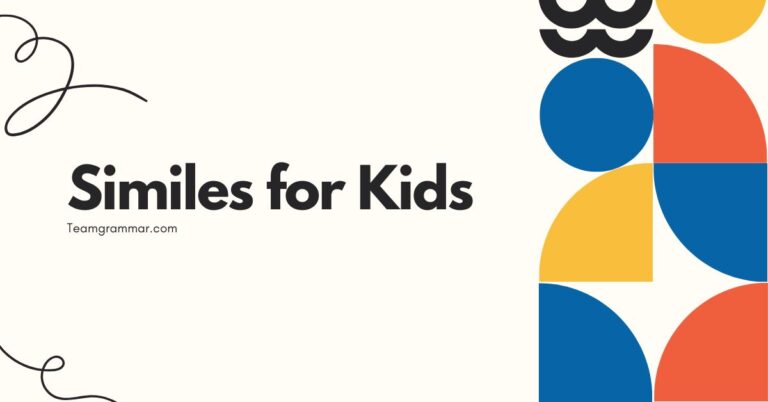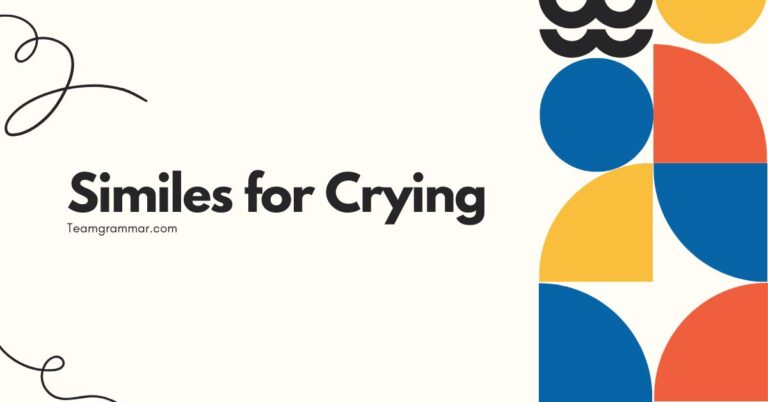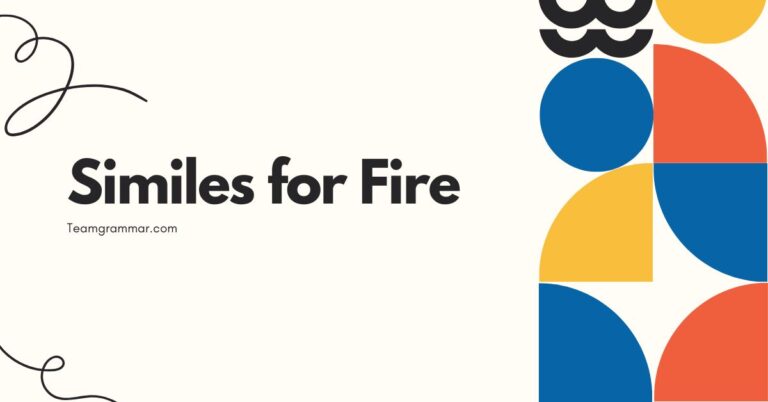43 Similes for Fast: A Comprehensive Grammar Guide
Understanding similes is crucial for enhancing your descriptive writing and adding vividness to your language. Similes, a type of figurative language, compare two unlike things using “like” or “as,” allowing you to create memorable images and convey ideas more effectively.
This article delves into the world of similes for “fast,” exploring various examples, structural elements, usage rules, and common mistakes. Whether you’re a student, writer, or language enthusiast, this guide will equip you with the knowledge and skills to master similes and enrich your communication.
Table of Contents
- Definition of Simile
- Structural Breakdown of Similes
- Types of Similes for Fast
- Examples of Similes for Fast
- Usage Rules for Similes
- Common Mistakes with Similes
- Practice Exercises
- Advanced Topics in Similes
- Frequently Asked Questions
- Conclusion
Definition of Simile
A simile is a figure of speech that compares two unlike things using the words “like” or “as.” Its primary function is to create a vivid image or convey a specific quality by associating it with something familiar or easily understood. Similes are used extensively in literature, poetry, and everyday conversation to make descriptions more engaging and impactful.
By drawing a comparison, similes help to clarify meaning, evoke emotions, and add depth to communication. They differ from metaphors, which directly equate two things without using “like” or “as.”
In the context of describing speed, similes using “fast” can paint a picture of rapid movement or quick action. They help the reader or listener visualize the speed by relating it to something else known for its quickness.
For instance, saying someone runs “as fast as a cheetah” immediately conveys a sense of incredible speed. Similes bring energy and dynamism to descriptions, making them more compelling and memorable.
Structural Breakdown of Similes
The basic structure of a simile includes three main components: thesubjectbeing described, thelinking word(“like” or “as”), and theobject of comparison. The subject is the entity whose characteristic is being highlighted, in this case, something related to speed.
The linking word establishes the comparison. The object of comparison is something that embodies the quality of speed being described.
Understanding this structure allows for the creation of effective and clear similes.
For example, in the simile “He ran as fast as the wind,” “He” is the subject, “as fast as” is the linking phrase, and “the wind” is the object of comparison. The simile effectively communicates the speed of his running by associating it with the swiftness of the wind.
This structured approach ensures that the comparison is both understandable and impactful. Variations exist, but the core elements remain constant to maintain clarity.
Types of Similes for Fast
Similes for “fast” can be categorized based on the objects of comparison used. These categories include animals known for their speed, natural phenomena, vehicles, and abstract concepts.
Each category provides a unique set of images and associations that can be used to describe speed effectively.
Animal-Based Similes
Animal-based similes use the speed of various animals to describe how fast something is. These similes often evoke a sense of natural agility and swiftness.
Common examples include comparing someone’s speed to that of a cheetah, a hare, or a falcon. Each animal brings its own unique connotation to the comparison, enhancing the descriptive power of the simile.
Nature-Based Similes
Nature-based similes draw on natural phenomena to illustrate speed. Examples include comparing speed to the wind, lightning, or a rushing river.
These similes often convey a sense of uncontrollable force and rapid movement. The vastness and power of nature can add significant impact to the comparison.
Vehicle-Based Similes
Vehicle-based similes use the speed of different vehicles to describe how fast something is. Examples include comparing speed to that of a race car, a jet plane, or a rocket.
These similes often evoke a sense of technological advancement and extreme velocity. The use of vehicles can also add a modern and dynamic element to the description.
Abstract Similes
Abstract similes use abstract concepts to convey speed. Examples include comparing speed to the passage of time, the speed of thought, or the spread of information.
These similes often add a layer of complexity and depth to the description. They can be particularly effective in conveying the subjective experience of speed.
Examples of Similes for Fast
The following tables provide a wide range of similes for “fast,” categorized for clarity and ease of reference. Each category offers unique ways to describe speed, allowing for flexibility and creativity in writing.
These examples demonstrate how different objects of comparison can be used to create vivid and impactful descriptions.
Animal-Based Similes Examples
This table showcases similes that compare speed to the swiftness of various animals. Each example provides a unique perspective on how animal agility can represent rapid movement.
| Simile | Explanation |
|---|---|
| As fast as a cheetah | Implies extreme speed and agility. |
| As quick as a hare | Suggests rapid, darting movements. |
| As swift as a falcon | Conveys speed combined with precision. |
| Like a greyhound chasing a lure | Describes focused and relentless speed. |
| As speedy as a roadrunner | Evokes a sense of playful quickness. |
| Fast like a striking cobra | Suggests sudden and deadly speed. |
| As nimble as a squirrel | Conveys agility and quick reactions. |
| Quick like a hummingbird’s wings | Describes rapid, almost imperceptible movements. |
| As fast as a galloping horse | Implies powerful and sustained speed. |
| Speedy as a darting minnow | Suggests small but rapid movements. |
| Like a bat out of hell | Describes frantic and uncontrolled speed. |
| As fast as a fleeing deer | Conveys a sense of urgent escape. |
| Quick as a cat | Suggests agility and swift reflexes. |
| As swift as an eagle diving | Implies speed combined with power and precision. |
| Like a rocket-propelled snail | A humorous simile emphasizing unexpected speed. |
| As fast as a startled rabbit | Conveys sudden and reactive speed. |
| Quick as a weasel | Suggests sly and nimble movements. |
| As swift as a swallow in flight | Implies graceful and effortless speed. |
| Like a cheetah on the hunt | Describes focused and determined speed. |
| As speedy as a hummingbird | Evokes rapid and fluttering movements. |
| Fast like a striking snake | Suggests sudden and precise speed. |
| As nimble as a monkey | Conveys agility and quick reflexes. |
| Quick like a bee darting | Describes rapid, unpredictable movements. |
| As fast as a galloping zebra | Implies powerful and rhythmic speed. |
Nature-Based Similes Examples
This table illustrates similes that use natural phenomena to depict speed. These examples highlight the raw power and swiftness found in nature.
| Simile | Explanation |
|---|---|
| As fast as the wind | Implies uncontrollable and pervasive speed. |
| As quick as lightning | Suggests instantaneous and shocking speed. |
| As swift as a rushing river | Conveys powerful and relentless speed. |
| Like a bolt from the blue | Describes sudden and unexpected speed. |
| As speedy as a falling star | Evokes a sense of fleeting and magical speed. |
| Fast like a wildfire spreading | Suggests rapid and destructive speed. |
| As nimble as a breeze | Conveys light and effortless speed. |
| Quick like a sunbeam | Describes bright and immediate speed. |
| As fast as a tsunami | Implies overwhelming and unstoppable speed. |
| Speedy as an avalanche | Suggests massive and destructive speed. |
| Like a hurricane’s fury | Describes intense and devastating speed. |
| As fast as a landslide | Conveys sudden and catastrophic speed. |
| Quick as a shooting star | Suggests brief and remarkable speed. |
| As swift as a mountain stream | Implies clear and rapid speed. |
| Like a geyser erupting | Describes sudden and powerful speed. |
| As fast as melting snow | Conveys rapid and transformative speed. |
| Quick as a dust devil | Suggests swirling and unpredictable speed. |
| As swift as a shadow passing | Implies elusive and silent speed. |
| Like a wave crashing | Describes forceful and impactful speed. |
| As speedy as a tornado | Evokes destructive and chaotic speed. |
| Fast like a meteor shower | Suggests a multitude of rapid events. |
| As nimble as a ripple | Conveys subtle and spreading speed. |
| Quick like a flash flood | Describes sudden and overwhelming speed. |
| As fast as the tide coming in | Implies relentless and advancing speed. |
Vehicle-Based Similes Examples
This table provides similes that compare speed to various vehicles. These examples often convey a sense of modern technology and rapid transit.
| Simile | Explanation |
|---|---|
| As fast as a race car | Implies high speed and precision engineering. |
| As quick as a jet plane | Suggests rapid long-distance travel. |
| As swift as a rocket | Conveys extreme acceleration and velocity. |
| Like a bullet train | Describes efficient and modern speed. |
| As speedy as a motorcycle | Evokes a sense of freedom and agility. |
| Fast like a speeding train | Suggests unstoppable and linear speed. |
| As nimble as a sports car | Conveys maneuverability and quick response. |
| Quick like a drone | Describes agile and remote-controlled speed. |
| As fast as a fighter jet | Implies rapid tactical movements. |
| Speedy as a speedboat | Suggests exhilarating water-based speed. |
| Like a formula one car | Describes high-performance and cutting-edge speed. |
| As fast as a cruise missile | Conveys targeted and relentless speed. |
| Quick as a scooter | Suggests efficient urban mobility. |
| As swift as a satellite orbiting | Implies constant and predictable speed. |
| Like a monorail | Describes smooth and elevated speed. |
| As fast as a high-speed elevator | Conveys vertical and rapid transit. |
| Quick as a bicycle | Suggests human-powered and eco-friendly speed. |
| As swift as a helicopter | Implies versatile and hovering speed. |
| Like a race drone | Describes agile and competitive speed. |
| As speedy as a delivery van | Evokes efficient and reliable transport. |
| Fast like a taxi on a meter | Suggests determined and paid speed. |
| As nimble as a rickshaw | Conveys human-powered and agile speed. |
| Quick like a fire engine | Describes urgent and life-saving speed. |
| As fast as an ambulance | Implies critical and responsive speed. |
Abstract Similes Examples
This table presents similes that use abstract concepts to describe speed. These examples often add a layer of complexity and depth to the comparison.
| Simile | Explanation |
|---|---|
| As fast as the passage of time | Implies an unstoppable and relentless pace. |
| As quick as a thought | Suggests instantaneous and intangible speed. |
| As swift as the spread of information | Conveys rapid dissemination and influence. |
| Like a rumor spreading | Describes uncontrollable and pervasive speed. |
| As speedy as light | Evokes the ultimate and universal speed. |
| Fast like a dream fading | Suggests fleeting and ephemeral speed. |
| As nimble as an idea sparking | Conveys sudden and innovative speed. |
| Quick like a memory flashing | Describes brief and vivid speed. |
| As fast as progress advancing | Implies relentless and forward momentum. |
| Speedy as change occurring | Suggests inevitable and transformative speed. |
| Like an emotion surging | Describes powerful and overwhelming speed. |
| As fast as technology evolving | Conveys continuous and accelerating speed. |
| Quick as a decision being made | Suggests immediate and impactful speed. |
| As swift as justice being served | Implies efficient and fair speed. |
| Like a trend catching on | Describes rapid and widespread adoption. |
| As fast as a heartbeat | Conveys vital and rhythmic speed. |
| Quick as a reaction | Suggests immediate and responsive speed. |
| As swift as an opportunity passing | Implies fleeting and valuable speed. |
| Like a secret spreading | Describes covert and pervasive speed. |
| As speedy as news traveling | Evokes rapid and widespread dissemination. |
| Fast like a desire growing | Suggests intense and escalating speed. |
| As nimble as an excuse | Conveys quick and evasive speed. |
| Quick like an answer appearing | Describes sudden and insightful speed. |
| As fast as the stock market changing | Implies volatile and unpredictable speed. |
Usage Rules for Similes
When using similes, it’s essential to ensure that the comparison is both logical and effective. The two things being compared should share a relevant characteristic, and the comparison should enhance the description.
Avoid clichés and strive for originality to make your writing more impactful. Additionally, ensure that the simile fits the tone and context of your writing.
Clarity is key. The reader should be able to understand the comparison without confusion.
If the object of comparison is too obscure or unfamiliar, the simile will lose its effectiveness. Always consider your audience and choose comparisons that resonate with their knowledge and experience.
The goal is to illuminate the subject, not to obfuscate it. The use of similes should be intentional and contribute meaningfully to the overall message.
Common Mistakes with Similes
One common mistake is using clichés. Overused similes like “as fast as lightning” can lose their impact.
Another mistake is comparing things that don’t have a clear connection, leading to confusion. Additionally, mixing metaphors and similes can create illogical and jarring imagery.
It is also important to ensure grammatical correctness when constructing similes.
Here are some examples of common mistakes and their corrections:
| Incorrect | Correct | Explanation |
|---|---|---|
| He was as fast as fast. | He was as fast as a race car. | Using the same word is redundant. |
| She ran like a house. | She ran like the wind. | The comparison must be logical. |
| The idea spread like wildfire, but it was a slow burn. | The idea spread like wildfire. | Avoid mixing similes and conflicting expressions. |
| He run as fast as a cheetah. | He ran as fast as a cheetah. | Ensure correct verb tense and agreement. |
Practice Exercises
Test your understanding of similes with these exercises. Fill in the blanks to complete the similes, or create your own similes based on the given prompts.
These exercises are designed to reinforce your ability to use similes effectively and creatively.
Exercise 1: Completing Similes
Complete the following similes using appropriate comparisons. Focus on making the comparisons logical and vivid.
| Question | Answer |
|---|---|
| 1. He moved as fast as a __________. | 1. He moved as fast as a striking cobra. |
| 2. The news spread as quickly as __________. | 2. The news spread as quickly as wildfire. |
| 3. The car sped off like __________. | 3. The car sped off like a rocket. |
| 4. Her thoughts raced as fast as __________. | 4. Her thoughts raced as fast as lightning. |
| 5. The river flowed as swiftly as __________. | 5. The river flowed as swiftly as a mountain stream. |
| 6. He reacted as quick as __________. | 6. He reacted as quick as a cat. |
| 7. The rumor spread as fast as __________. | 7. The rumor spread as fast as the wind. |
| 8. She ran like __________. | 8. She ran like a cheetah on the hunt. |
| 9. The child darted away as speedy as __________. | 9. The child darted away as speedy as a roadrunner. |
| 10. The runner sprinted fast like __________. | 10. The runner sprinted fast like a race car. |
Exercise 2: Creating Similes
Create your own similes for the following scenarios, focusing on speed. Be creative and strive for originality.
| Scenario | Simile |
|---|---|
| 1. Describing a fast computer. | 1. The computer processes data as fast as a supercomputer. |
| 2. Describing a quick decision. | 2. The decision was made as quick as a thought. |
| 3. Describing a fast-moving storm. | 3. The storm moved as fast as a runaway train. |
| 4. Describing a speedy delivery service. | 4. The delivery service was as fast as a drone. |
| 5. Describing a fast-growing plant. | 5. The plant grew as fast as bamboo shoots. |
| 6. Describing a fast-paced song. | 6. The song raced by as fast as a bullet train. |
| 7. Describing a fast download. | 7. The download completed as quick as a flash. |
| 8. Describing a fast typist. | 8. The typist’s fingers moved as fast as hummingbird wings. |
| 9. Describing a fast car. | 9. The car accelerates as fast as a rocket launching. |
| 10. Describing a fast river. | 10. The river flowed as swift as a freed bird. |
Advanced Topics in Similes
For advanced learners, exploring the nuances of similes can lead to more sophisticated and impactful writing. Consider the cultural connotations of different comparisons.
What might resonate with one audience may not with another. Experiment with unexpected or unconventional comparisons to create unique effects.
Also, explore the use of extended similes, where the comparison is developed over several sentences or even paragraphs.
Furthermore, consider the interplay between similes and other figures of speech, such as metaphors and personification. How can these techniques be combined to create richer and more complex imagery?
Analyzing the use of similes in literature can provide valuable insights into their potential and effectiveness. Pay attention to how skilled writers use similes to convey meaning, evoke emotion, and create memorable scenes.
Frequently Asked Questions
- What is the difference between a simile and a metaphor?
A simile compares two unlike things using “like” or “as,” while a metaphor directly equates them without using these words. For example, “He is as fast as a cheetah” is a simile, whereas “He is a cheetah on the track” is a metaphor.
- Why use similes in writing?
Similes enhance descriptive writing by creating vivid images and making abstract concepts more understandable. They add depth, clarity, and engagement to your communication, making it more impactful and memorable.
- How can I avoid using clichés in my similes?
Strive for originality by thinking beyond common comparisons. Consider unique characteristics of the subject and look for less obvious objects of comparison. The more specific and tailored the simile, the more effective it will be.
- Can a simile be too complex?
Yes, if the object of comparison is too obscure or unfamiliar, the simile may lose its effectiveness. Clarity is key. Ensure that the comparison is easily understood by your audience.
- Are similes only used in formal writing?
No, similes are used in various contexts, including informal conversations, creative writing, and marketing materials. They can add flair and clarity to any form of communication.
- How do I choose the right simile for a given situation?
Consider the tone, context, and audience. The simile should align with the overall message and resonate with the intended readers or listeners. Choose comparisons that enhance the description and convey the desired meaning.
- Is it possible to overuse similes?
Yes, overusing similes can make your writing feel forced and repetitive. Use them sparingly and strategically to maximize their impact. Balance them with other descriptive techniques.
- What role do similes play in poetry and literature?
Similes are essential tools for poets and writers, enriching their work with imagery, emotion, and depth. They help to create vivid scenes, convey complex ideas, and engage the reader’s imagination.
- How can I improve my ability to create effective similes?
Practice regularly, read widely, and pay attention to how skilled writers use similes. Experiment with different comparisons and solicit feedback from others. The more you practice, the better you will become at crafting impactful similes.
- Can similes be humorous?
Yes, similes can be used to create humor by comparing things in unexpected or absurd ways. Humorous similes can add levity and entertainment to your writing.
- How do cultural differences affect the use of similes?
Different cultures may have different associations and understandings of certain objects or concepts. What resonates with one culture may not with another. It is important to be aware of these differences and choose comparisons that are culturally appropriate.
- Are there any grammar rules specific to similes?
While there are no grammar rules *specific* to similes, normal grammar rules still apply. Ensure correct subject-verb agreement and pronoun use within the sentence containing the simile.
Conclusion
Mastering similes is an invaluable skill for anyone looking to enhance their descriptive writing and communication. By understanding the structure, types, and usage rules of similes, you can add depth, clarity, and vividness to your language.
Practice regularly, avoid common mistakes, and explore advanced techniques to unlock the full potential of this powerful figure of speech. The ability to craft effective similes will enrich your writing and make your communication more engaging and memorable, allowing you to paint pictures with your words and connect with your audience on a deeper level.
Remember, the key to success is practice, creativity, and a keen awareness of your audience.







